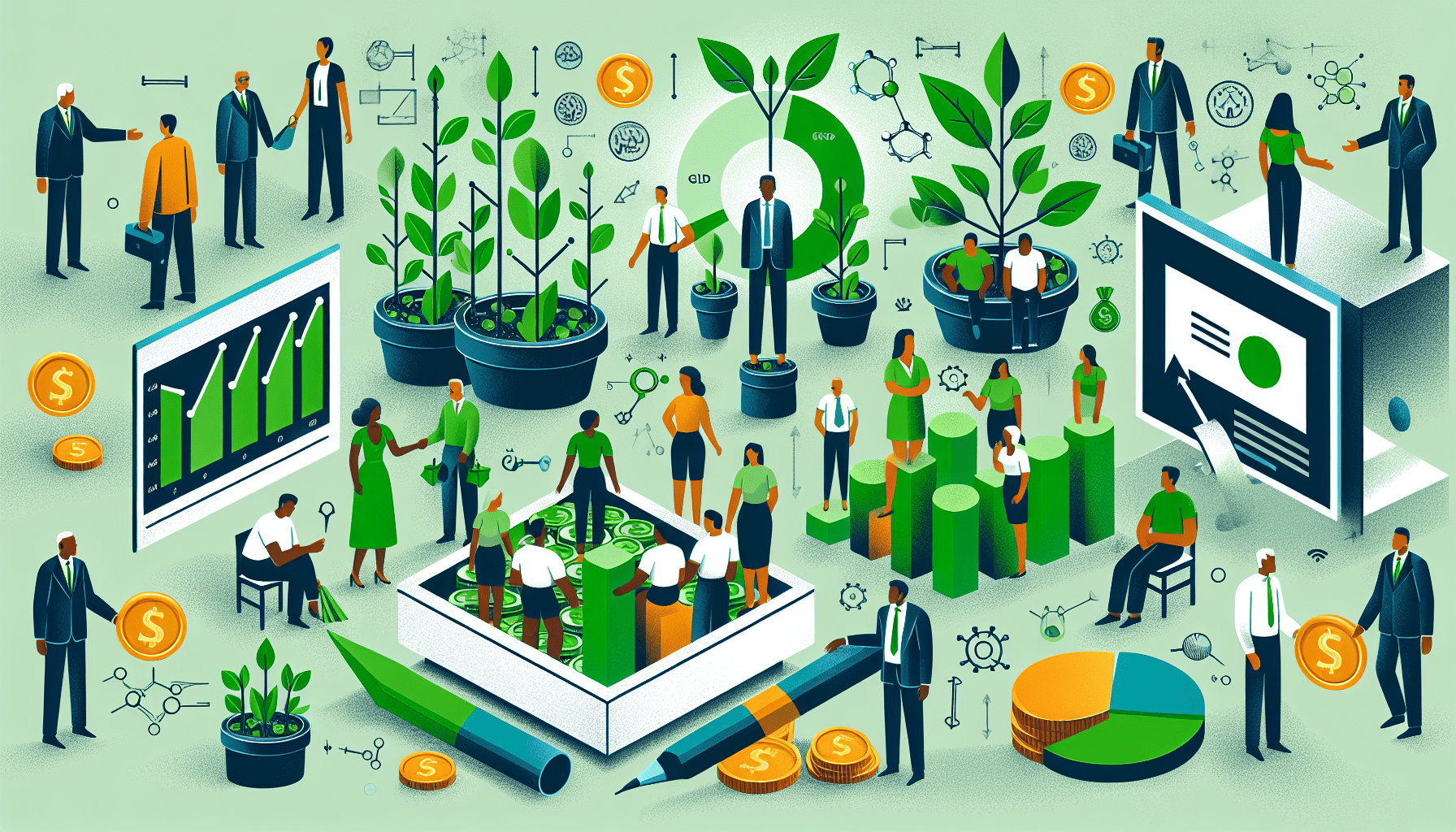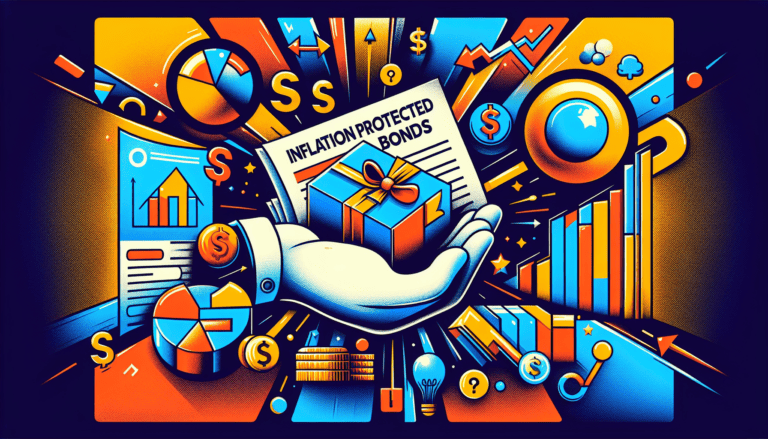Making a Difference with Green Bonds and Social Impact Investing

Introduction to Bond Markets
The bond market, also known as the fixed-income or debt market, is a financial marketplace where investors can purchase bonds issued by various entities. Bonds are investment securities representing a loan made by an investor to a borrower, typically corporate or governmental.
Basics of Bonds
Bonds function as a way for organizations to raise capital: an investor buys a bond, effectively lending money to the issuer in exchange for periodic interest payments and the return of the bond’s face value when it matures. The terms of this agreement are detailed in the bond’s indenture, which includes the interest rate, also known as the coupon rate, maturity date, and other conditions.
When investors purchase bonds, they are providing the issuer with the capital needed for various purposes, such as funding operations, investing in projects, or refinancing existing debts. Bonds are considered a more stable investment compared to stocks, as they usually provide regular income and return of principal at maturity. Investors can learn the basics of bond investing to familiarize themselves with these financial instruments.
Types of Bonds
There are several types of bonds available to investors, each with its own characteristics, risks, and benefits:
-
Government Bonds: Issued by national governments, these bonds are regarded as safe investments due to the low likelihood of default. They can offer stability and security to investors wary of market volatility. For more information, see government bonds: stability and security.
-
Municipal Bonds: Issued by states, cities, or other local government entities, these bonds often provide tax-advantaged income, making them an attractive option for investors in higher tax brackets. For details, visit municipal bonds: tax-advantaged investing.
-
Corporate Bonds: Corporations issue these bonds to fund new projects, maintain ongoing operations, or refinance existing debt. They typically offer higher yields than government bonds but carry higher risks. Investors can weigh these corporate bonds: risks and rewards.
-
High-Yield Bonds: Also known as junk bonds, these are issued by companies with lower credit ratings and carry a higher risk of default, but they offer higher interest rates as compensation. To understand these risks, read about high-yield bonds: understanding junk bonds.
-
Inflation-Protected Bonds: These bonds include mechanisms to protect investors from inflation, adjusting the principal value in line with inflation rates. For more on these bonds, explore inflation-protected bonds.
-
International Bonds: Investing in bonds from foreign markets can offer diversification and exposure to different economic conditions. Learn about international bonds: diversifying globally.
-
Convertible Bonds: These are hybrid bonds that investors can convert into a predetermined number of the company’s equity shares. This type of bond is explained in convertible bonds: bonds and equities hybrid.
Investors can purchase bonds individually or through bond funds, which pool money from many investors to buy a diversified portfolio of bonds. There are strategies to consider, such as the bond laddering strategy, which involves buying bonds with different maturities to manage interest rate risks and provide liquidity.
Understanding the types of bonds is crucial for investors looking to navigate the bond markets and make informed investment decisions, especially when considering specialized areas like green bonds and social impact investing.
Rise of Sustainable Investing
In recent years, the investment landscape has witnessed a transformative shift towards sustainability. Among the various instruments driving this change, green bonds have emerged as a pivotal tool for financing projects that yield environmental benefits and contribute to the broader goal of sustainable development.
Definition of Green Bonds
Green bonds are specialized financial instruments designed to raise funds for projects with positive environmental impacts. They operate similarly to traditional bonds but are exclusively used to finance or refinance projects that are environmentally friendly, such as renewable energy initiatives, pollution prevention, sustainable water management, and eco-friendly transportation systems. The primary goal of green bonds is to direct capital towards initiatives that can mitigate climate change and address environmental challenges, affirming the investor’s commitment to sustainability and responsible resource stewardship (NerdWallet).
Growth of Green Bonds Market
The market for green bonds has experienced substantial growth since the first issuance by the European Investment Bank in 2007. From modest beginnings, the global green bond market surpassed a cumulative total of $1 trillion in issuances by 2021, showcasing an escalating appetite among investors for eco-conscious investment opportunities (NerdWallet).
Below is a table reflecting the growth of the green bonds market:
| Year | Global Green Bond Issuance |
|---|---|
| 2012 | $3 billion |
| 2016 | $50 billion |
| 2019 | Over $260 billion |
| 2020 | $694 billion |
| 2021 | Over $1 trillion |
Data Sources: Investopedia, Wharton University of Pennsylvania
The exponential expansion of the market reflects a burgeoning recognition of green bonds as a credible and effective means of financing projects that are not only profitable but also environmentally advantageous. Issuers of green bonds have diversified beyond development banks to include entities such as governments, municipalities, and corporations, further broadening the scope of projects that can be financed (Investopedia).
Investors are increasingly drawn to green bonds for their perceived safety and the opportunity to align their portfolios with their environmental and social values. The demand continues to burgeon, fueled by institutional investors and a growing societal emphasis on sustainability (Investopedia).
For beginner investors interested in sustainable investment opportunities, understanding green bonds is a step towards participating in the market for environmental change. Complementing this knowledge with foundational concepts such as inflation-protected bonds and bond valuation techniques can help investors make informed decisions in the bond markets. To further explore the intricacies of bond investing, readers may refer to our comprehensive guide on the basics of bond investing.
Impact of Green Bonds
Green bonds have become a pivotal instrument in funding environmentally beneficial projects. Their impact extends beyond the financial return to investors, as they play a significant role in the global effort to promote sustainable practices and combat climate change.
Environmental and Climate Benefits
Green bonds are specifically designed to fund projects that provide clear environmental benefits and contribute to a reduction in carbon emissions. Since the inaugural issuance by the European Investment Bank in 2007, green bonds have been integral in financing initiatives across a variety of sectors, including renewable energy, pollution control, and sustainable land use.
These bonds are more than just financial tools; they represent a commitment to environmental stewardship and a proactive approach to mitigating climate change. They have the potential to significantly reduce greenhouse gas emissions and promote the transition to a low-carbon economy. By investing in green bonds, individuals and institutions are directly supporting projects that aim to preserve and protect our natural resources for future generations.
The table below outlines the different environmental benefits attributed to projects funded by green bonds:
| Project Type | Environmental Benefit |
|---|---|
| Renewable Energy | Reduces reliance on fossil fuels, lowers greenhouse gas emissions |
| Pollution Control | Improves air and water quality, promotes health |
| Sustainable Land Use | Preserves biodiversity, ensures sustainable agriculture practices |
Financing Sustainable Projects
Green bonds provide crucial funding for sustainable projects that might otherwise struggle to secure investment. NerdWallet highlights that these bonds can finance a diverse range of initiatives from renewable energy projects like wind farms and solar panels, to pollution prevention mechanisms, affordable eco-friendly housing, and clean transportation solutions.
The influx of capital from green bonds enables project developers to implement advanced technologies and infrastructure that contribute to a more sustainable future. The primary goal of these bonds is to support investments that not only generate financial returns but also prioritize the sustainable management of natural resources and address pressing environmental challenges (NerdWallet).
As the market for green bonds has expanded, with total issuance surpassing $1 trillion in 2022 (Investopedia), the range of projects benefiting from this financing has also broadened. This growth reflects a wider recognition among investors of the importance of incorporating environmental considerations into their portfolios.
For beginner investors looking to contribute to environmental and climate solutions while also seeking financial returns, green bonds offer a unique opportunity. Investors can further their understanding of bond markets and their various facets, such as bond valuation techniques, inflation-protected bonds, and bond laddering strategy, to make informed decisions when considering green bonds within their investment strategies.
Understanding Social Impact Investing
Social impact investing is an approach that seeks to not only provide financial returns but also create constructive social or environmental effects. This strategy aligns investor’s portfolios with their values, supporting initiatives that contribute positively to society or the environment.
Principles of Impact Investing
Impact investing operates on the principle that investments should address social and environmental challenges while generating financial returns. This dual-purpose investing aligns with the growing demand for responsible investments that reflect personal ethics and societal concerns. Investors in this space aim to support economic growth and innovation in areas that traditional markets may overlook or underfund.
The core principles, as outlined by industry leaders and organizations, encompass the following:
- Intentionality: An investor’s intent to generate social or environmental impact through investments is fundamental to impact investing.
- Investment with Return Expectations: Impact investments are expected to yield a financial return on capital or, at minimum, a return of capital.
- Range of Return Expectations and Asset Classes: Impact investments target financial returns that range from below market to market rate, depending on investors’ strategic goals.
- Impact Measurement: The commitment to measure and report the social and environmental performance and progress of underlying investments is crucial in ensuring transparency and accountability.
The Global Impact Investing Network (GIIN) emphasizes the importance of these principles in the growing market for impact investments.
Areas of Focus in Social Investing
Social impact investors channel funds into various sectors that address key societal and environmental issues. According to the GIIN, impact investors concentrate on five key areas:
- Access to healthcare
- Clean energy
- Sustainable agriculture
- Affordable housing
- Financial services
Each sector represents a critical challenge and opportunity for progress. For example, investing in clean energy supports the transition to sustainable energy sources, while investments in affordable housing aim to improve living conditions and combat homelessness. Financial services, such as microfinance, provide underserved communities with access to credit and banking, fostering economic empowerment.
Here is a representation of the focus areas and their respective impacts:
| Focus Area | Intended Impact |
|---|---|
| Access to healthcare | Improve health outcomes and accessibility |
| Clean energy | Promote environmental sustainability and innovation |
| Sustainable agriculture | Enhance food security and sustainable practices |
| Affordable housing | Address housing shortages and improve living conditions |
| Financial services | Increase financial inclusion and economic opportunity |
Impact investing provides an avenue for investors to contribute actively to positive change while pursuing financial gains. By selecting investments that align with personal values and societal goals, investors can be part of the solution to global challenges while potentially earning a return.
For further insights on the bond markets and how green bonds and social impact investing fit within the broader financial landscape, explore topics like inflation-protected bonds and bond valuation techniques. Understanding these foundational elements can enhance investors’ ability to make informed decisions that align with both their financial objectives and their commitment to sustainability.
Investing in Green Bonds
For individuals interested in aligning their investments with their environmental values, green bonds offer an opportunity to contribute to sustainable projects while potentially earning financial returns. Here we’ll discuss how these instruments might fit into a financial portfolio, examining both the potential returns and the factors to consider when evaluating green bond investments.
Financial Returns and Benefits
Investors typically seek a balance between financial gains and contributing positively to the environment when it comes to green bonds. A study by the Bank for International Settlements (BIS) found that green bonds from the same issuer often trade at lower yields (or higher prices) compared to their non-green counterparts, though the variance of this “green premium” is quite high and not always statistically significant.
| Bond Type | Yield Premium |
|---|---|
| Green Bonds (vs. Traditional Bonds) | 10 bps to 45 bps lower |
However, research from the Sorbonne indicates that in the US, green corporate and municipal bonds trade at an average yield premium of 8 bps relative to non-green bonds from the same issuer. This suggests that investors may be willing to accept slightly lower yields in exchange for the environmental benefits that these bonds support.
When considering the financial returns of green bonds, it’s important to compare them with other fixed-income investments, such as inflation-protected bonds, corporate bonds, and municipal bonds. Investors should assess the creditworthiness of the issuer, the bond’s maturity, and the current interest rate environment to understand the potential risks and rewards.
Evaluating Green Bond Investments
Evaluating green bonds involves more than just looking at the financials; it’s also about ensuring that the investment aligns with environmental objectives. Here are some factors investors might consider:
- Project Impact: Review the sustainability projects funded by the bond to ensure they align with your environmental goals. This may include renewable energy initiatives, green building developments, or pollution control projects.
- Transparency and Reporting: Check if the issuer provides regular reports on the progress of the funded projects and the environmental impact achieved.
- Certification: Look for bonds certified by reputable third parties, such as the Climate Bonds Initiative, which can provide assurance of the bond’s green credentials.
- Market Dynamics: Understand the secondary bond market dynamics and how green bonds may perform in different market conditions.
- Issuer’s Track Record: Examine the issuer’s history in terms of both financial stability and commitment to environmental issues.
- Yield Comparison: Compare the yields of green bonds to traditional bonds using bond valuation techniques to determine if the investment makes sense for you.
Investors might also consider if there are systemic differences between issuers of green and traditional bonds that could influence their decision. According to the CFA Institute, motivations behind investing in green bonds can range from risk management to emotional factors, beyond just the potential financial returns.
In conclusion, while investing in green bonds might offer lower yields compared to traditional bonds, the environmental benefits and the growth of the sustainable investing market can make them an attractive option for socially-conscious investors. Before making any investment decisions, it is recommended to conduct thorough research and consider a diversified investment strategy, potentially including international bonds and high-yield bonds, to balance risks and returns.
Market Trends and Transparency
The financial landscape is witnessing a significant shift towards sustainability, with green bonds and social impact investing emerging as pivotal elements. This shift is characterized by both the growth and diversification of the market, as well as the increasing importance of standardization to maintain the market’s integrity and transparency.
Growth and Diversification
The green bond market has experienced remarkable growth, evolving from a niche offering to a mainstream financial instrument. Initially dominated by development banks, the market now sees a variety of issuers including governments, municipalities, and corporations. This broadening issuer base has contributed to the diversification of projects financed by green bonds, ranging from renewable energy initiatives to sustainable water management systems.
According to Investopedia, this expansion reflects a growing recognition of the importance of environmentally focused projects in achieving sustainable development goals.
| Year | Green Bond Issuance (USD) |
|---|---|
| 2015 | 41.8 Billion |
| 2016 | 81.6 Billion |
| 2017 | 155.5 Billion |
| 2018 | 167.3 Billion |
| 2019 | 257.7 Billion |
The increasing interest in sustainable investments can be seen in the upward trajectory of green bond issuance, which underscores the importance of such financial instruments in today’s economy.
Importance of Standardization
With the proliferation of green bonds, standardization has become crucial to ensure that investors can rely on the environmental claims made by bond issuers. Transparency about the environmental impact of the projects funded is necessary to build trust and credibility in the market. Guidelines and principles, such as the Green Bond Principals (GBPs) and Climate Bonds Standard (CBS), have been developed to promote integrity in the green bond market by advising on the use of funds, project selection, and reporting practices (Better Building Solutions Center).
Green bond issuers often create a green bond framework that outlines their environmental objectives and how they plan to achieve them. Although issuers can self-label their bonds as ‘green,’ it is the adherence to these established principles and guidelines that lends credibility to their claims. The absence of a singular governing body to oversee these issuances means that the responsibility falls on the issuers themselves to ensure they meet high credit standards and provide transparency to investors (Better Building Solutions Center).
The ongoing dialogue around standardization and transparency is essential for the green bond market’s continued growth and for affirming investor confidence. As investors increasingly prioritize environmental impact alongside financial returns, the market for green bonds and social impact investing is poised to expand further. Understanding these market trends is fundamental for anyone involved in bond valuation techniques, strategies for fixed income portfolios, or simply exploring the basics of bond investing.
Future of Sustainable Bonds
The future of sustainable bonds, including green bonds and social impact investing, is a topic that carries significant implications for the financial markets and the broader effort to address environmental and societal challenges. While the market for these financial instruments has seen remarkable growth, it also faces unique hurdles and possibilities that could shape its trajectory.
Challenges and Opportunities
The sustainable bond market’s impressive expansion has brought with it a set of challenges and opportunities. One of the primary concerns is the need for standardization and transparency. Investors require assurance that the funds they invest are genuinely contributing to environmental and social advancements. To address this, various organizations have developed guidelines to maintain the integrity of green bonds and clarify the environmental impact of financed projects (Investopedia).
A continued opportunity for sustainable bonds is their ability to attract a diverse group of issuers, ranging from development banks to corporations and municipalities. This diversity enables a broader range of projects to receive funding, from renewable energy initiatives to sustainable infrastructure development (Investopedia).
Another challenge is the risk of greenwashing, where the environmental benefits of a bond issue may be overstated. This underscores the importance of credible third-party verification and certification processes to validate the environmental claims made by issuers.
On the flip side, the opportunities are vast. As the global green bond market surpassed $1 trillion in cumulative issuances in 2021, it is clear that investor appetite for environmentally friendly investments is robust (NerdWallet). Moreover, sustainable bonds often come with financial incentives, such as tax benefits, which can make them an attractive proposition for investors.
Investor Interest and Market Potential
The potential of the sustainable bond market is significant, as evidenced by the rapid growth in green bond issuances, which soared from $3 billion in 2012 to over $260 billion by the end of 2019 (Investopedia). Investor interest is largely fueled by the desire to align financial portfolios with environmental and social values while also seeking out safe and potentially cost-effective investment options.
Institutional investors, in particular, are increasingly drawn to green bonds due to their alignment with long-term investment horizons and environmental, social, and governance (ESG) goals. This surge in demand suggests considerable market potential and a trend that is likely to continue as more investors seek to contribute to positive change through their investment choices.
The global landscape of sustainable bonds is dynamic, and as the market matures, it is expected to offer a wide array of investment opportunities. For beginner investors looking to navigate this space, gaining a foundational understanding of bond markets and familiarizing themselves with bond valuation techniques will be crucial.
Sustainable bonds represent not just a financial choice but a step towards a more responsible and forward-thinking investment strategy. The ongoing development of this market will likely be characterized by increased regulatory support, innovation, and a collaborative effort to overcome challenges, all while harnessing the growing interest from a new generation of impact-focused investors.





